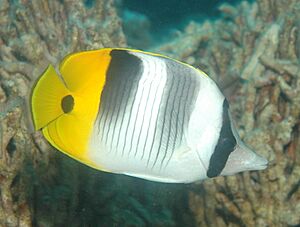Pacific double-saddle butterflyfish facts for kids
Quick facts for kids Pacific double-saddle butterflyfish |
|
|---|---|
 |
|
| Conservation status | |
| Scientific classification | |
| Genus: |
Chaetodon
|
| Species: |
ulietensis
|
| Synonyms | |
|
|
The Chaetodon ulietensis, also known as the Pacific double-saddle butterflyfish, is a type of butterflyfish. These fish live in places with lots of coral in the central Indo-Pacific region. You can find them from the Cocos-Keeling Islands all the way to the Tuamotu Islands. They also live north towards Japan.
They usually swim in shallow waters, from the surface down to about 20 m (66 ft). They especially like shallow channels where the water moves fast.
Contents
About the Pacific Double-Saddle Butterflyfish
What Does It Look Like?
These fish can grow up to 15 cm (5.9 in) long. Their bodies are white with thin black lines going down vertically. They have two dark, saddle-shaped spots on their back. These spots blend softly into the color of their tail area.
Right after the back saddle, their body and tail turn bright yellow. There is also a black spot on the part of the body where the tail fin connects, called the caudal peduncle. A streak of yellow runs along their dorsal fin, from their head to their tail. Like many butterflyfish, they have a black band over their eyes, like a mask. When they are scared or it is nighttime, their colors can become lighter.
This fish belongs to a large group of butterflyfish called Rabdophorus. Its closest relative is the black-wedged butterflyfish, C. falcula, which looks very similar. Other relatives include the lined (C. lineolatus) and spot-naped butterflyfishes (C. oxycephalus). The blue-cheeked butterflyfish (C. semilarvatus) is an older relative. All these fish have vertical lines on their bodies. The white body with yellow at the back and black on the back and tail base is common among the four less ancient species.
Where Does It Live and What Does It Eat?
The Pacific double-saddle butterflyfish often lives alone or in pairs. They are found on reef systems rich in coral. They search for food like small invertebrates that stay in one place and algae. This fish does not protect a specific area. It swims freely around reefs, lagoons, and harbors to find food. Sometimes, many of these fish gather in places with lots of food.
You will rarely see them in very deep reefs or the open ocean. Young fish usually grow up in shallow lagoons, estuaries, or harbors. This fish eats many different things. Its diet mainly includes tiny algae, other small sea creatures called plankton, and small invertebrates that are attached to surfaces. To stay safe from predators, they often hide by squeezing into tight cracks in the coral.
Living in an Aquarium
Even though these fish are common in the wild, they are not often kept in home aquariums. For people who keep fish, this butterflyfish is known to be strong and healthy. It is also helpful for controlling unwanted pests in a tank. The Pacific double-saddle butterflyfish has been seen eating Aiptasia and Majano sea anemones. These anemones can be a problem in aquariums.
Like most Raccoon Butterflyfish (C. lunula), C. ulietensis can get rid of these pest anemones. This usually takes about 2 to 6 weeks, depending on how many anemones there are and the size of the tank. Unlike many raccoon butterflyfish, this species rarely eats the decorative corals in an aquarium. The Pacific double-saddle butterflyfish easily eats most frozen and dry fish foods. This makes it easier for them to get used to living in an aquarium. Other butterflyfish, like the Copperband Butterflyfish (Chelmon rostratus), can be harder to care for.


